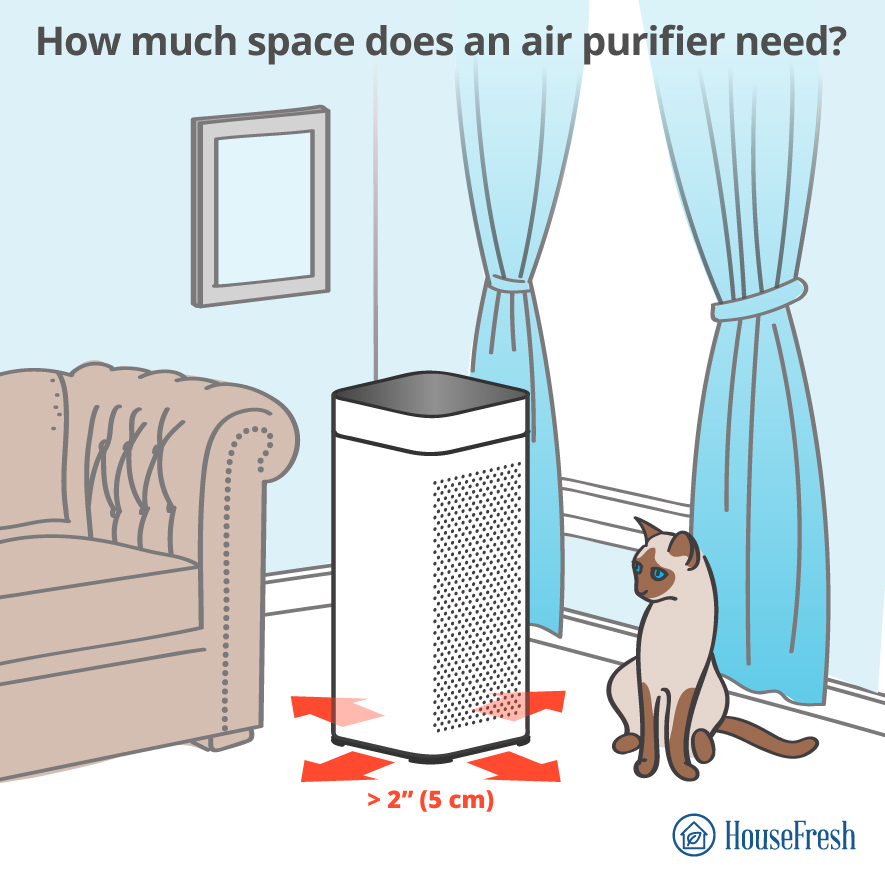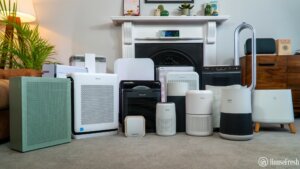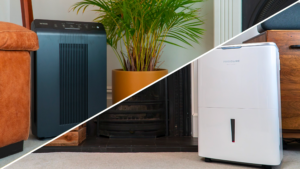Whether you’ve just bought an air purifier and are at a loss on how to use it, or still deliberating if taking the plunge on a purifier is worth the money, we’ve set the record straight on the benefits they provide and how you can easily achieve them in just a few simple steps.
From how long to run it for to tips on maximizing airflow, we’ve covered all the questions that often leave air purifier owners stumped, so be sure to read on to find out how to get the most out of your unit.
How to use an air purifier for optimum performance
To reap the best rewards from your air purifier, take a look at these simple tips that will help keep your air feeling as healthy and fresh as possible.
Rule 1: Replace the filters at the right time
The filters of the air purifier, both HEPA and Carbon, play a pivotal role in keeping dust and other impurities at bay. Over time, however, they will become saturated with pollutants and lose efficiency. As a result, it is important to clean and replace the filters at the designated time.
Read the specific guidelines for filter replacement carefully to ensure optimal air purifier operation.
Rule 2: Close doors and windows
When using an air purifier at home, ensure you close all the doors and windows. If the window is open, the purified air inside a room will escape, while dirty air will be allowed to flow inside. Air purifiers are designed to work at their best when used in confined spaces such as closed rooms.
You can open the doors and windows for proper ventilation and achieve a short burst of fresh air during the day. But be sure to close the doors and windows when you use the air purifier.
Rule 3: Leave it to run around the clock
You may think we’re crazy to advise that you run an electrical appliance 24 hours a day, given the current energy costs. But by running the purifier around the clock, you can achieve a consistent level of clean air without compromise.
By running it more frequently, you will only have to use the lower fan speeds, which are more energy efficient than intense blasts on a turbo setting, even if this is done less frequently.
Rule 4: Clean it regularly
Carrying out regular maintenance and cleaning to the unit itself will help the purifier do its job more efficiently. This step won’t take long but requires you to check and clean the pre-filter to clear any particle build-up and ensure that the air vents are free from dust and debris.
Where to place your air purifier
Putting your air purifier in the right place will help maximize efficiency, but knowing exactly where isn’t as obvious as you think. Check out the following steps to learn our top tips on purifier placement.
Placement rule 1: Give it room to breathe
Air purifiers work by drawing in vast amounts of air before filtering out pollutants and redistributing clean air back into the space. To do so, they need to be able to capitalize on the airflow in the room without obstruction. You’ll be able to easily locate the air intake and outlet vents on your unit, so the first port of call is to ensure they aren’t blocked in any way.
This also means you can’t pop your unit in the corner, pressed against the wall or behind bulky furniture. It’s best to allow at least 5 cm on either side of the unit to enable air to flow in and out efficiently.

Placement rule 2: Put it near the door
To help your unit blend into the background without compromising performance, place your purifier near a door or window to benefit from air movement and capture incoming particles without being the centerpiece of a room.
Placement rule 3: Keep it away from other electrical appliances
As well as potentially obstruct airflow, placing your air purifier near other electrical appliances, such as the TV or microwave, can affect its functionality. As competing electrical signals can cause interference with your purifier.
Placement rule 4: Consider the height of the purifier
If you have a larger air purifier, placing your unit on the floor is the best option. Yet for smaller units, it can be beneficial to place them on top of a table or shelf so that they can take advantage of the changing air currents in the room.
Placement rule 5: Place it near predominant pollutant sources
We hate playing the blame game, but we often find hotspots for pollutants in many homes. Be it allergens from the dog’s bed, odors from the kitchen or fumes coming in through a window. If this is the case in your home, it’s a great idea to tackle these pollutants head-on, placing the purifier as near to the source as possible.
Placement rule 6: Avoid high-traffic areas
The last thing you want to do is put your air purifier in an inconvenient location. Placing it in the middle of the room or a tight passage will only frustrate you in the long run, and you may see it shoved into the cupboard or corner as a result. Take a moment to think about where you can place the unit that will maximize airflow but minimize inconvenience.
5 benefits of using an air purifier, backed by science
If you’re not yet convinced that an air purifier is right for you, check out these five reasons, each backed up by scientific study, that are sure to lay any doubts to rest.
1. They help to stop the spread of airborne disease
HEPA filtration allows air purifiers to catch microscopic particles, including bacteria and viruses. A study published in the scientific journal Clinical Infectious Diseases and conducted in a coronavirus intensive care unit found that while running an air purifier, the highly infectious particles could not be found in the air, helping to prevent the spread of the virus.
2. They can relieve asthma and allergy symptoms
The home is full of particles such as dust, pollen and mold spores that can trigger allergies and respiratory conditions such as asthma.
Studies, such as one published in the Yonsei Medical Journal, have shown that when using an air purifier overnight, the need for medication to control flare-ups amongst children was dramatically reduced, allowing purifier users to breathe much easier.
3. They work to remove household odors
Air purifiers that utilize Activated Carbon filters can help eliminate any unwanted odor from your space. This technology has been tried and tested over the years, helping to rid sewer smells that permeated through the streets, to more modern applications, such as the odor-eliminating shoe insert used by NASA.
The same technology can be found in many air purifier filters and has proven to adsorb unpleasant odors as they pass through the unit.
4. They can help you get a better night’s sleep
Experiencing poor quality sleep is commonly attributed to irritants and allergens in the air. This led to scientists from the European Sleep Research Society investigating whether an air purifier could help, seeing a significant increase in the time participants spent asleep.
Researchers behind the Sleep journal experienced similar findings — participants felt that they fell asleep faster and were often able to sleep through the night, especially amongst those who struggled with pre-existing sleep disorders.
5. They combat harmful VOC pollutants
Whether you live in an area adversely affected by radon, or you have home furnishings or use cleaning products that emit harmful toxins like formaldehyde, there are plenty of sources (known as VOCs) that affect indoor air quality. Be sure to look at what we think is the best air purifier for VOCs, as they units required are very different to issues like pollen or air pollution.
The Activated Carbon filter in your air purifier can capture these harmful pollutants through a process known as adsorption.
Extensive research, conducted by the Department of Chemistry and Biochemistry at the University of New York has found that carbon-based adsorption is a highly efficient and cost-effective method for reducing formaldehyde.
While studies have also found that air purifiers are excellent tools to reduce levels and mitigate radon risks.
Frequently asked questions about how to use your air purifier
If your air purifier is predominately used in the bedroom, running it through the night can provide some excellent benefits that enable a better night’s sleep. We advise placing the unit on a nightstand or set of drawers near the bed, so you reap the benefits of clean air through the night.
If, however, you are a very light sleeper or get disturbed easily, you may be reluctant to utilize an air purifier in the bedroom. There are now many air purifiers with ultra-quiet sleep modes or even units that emit a sleep-inducing pink-noise hum to help you drift off.
The best advice we can offer is to let the air purifier run all day and night so you can rest assured the air you breathe is free from nasty pollutants. This may sound excessive, but the trick is to let the unit run at its lowest speed, which usually draws minimal electricity and runs discretely to achieve consistent results.
Suppose your purifier has an Auto feature that monitors the level of pollutants in the room and adjusts the fan speeds accordingly. In that case, you can be confident it is using less energy overall but still tackling the changing levels of particulate matter whenever required.
If this isn’t an option, you can utilize the purifier more strategically when you’re at home. Starting with a short stint on Turbo mode to clear the space of particles before reducing to a lower fan speed. Most air purifiers come with a timer function, so you may even be able to program your unit to clear the space before you return from work.
The best place to put your air purifier is in the room you spend the most time in or with the most pressing air quality issue, such as mold. Once you’ve decided which room, you will need to find the optimum spot. This needs to be somewhere that maximizes airflow, such as near a window, doorway or elevated if you have a smaller unit, without being inconvenient to whoever uses the space.
Remember, you must allow adequate space around the purifier so that it can draw in and expel air without obstruction. This means it needs to be at least 5 cm away from any wall or bulky piece of furniture.
You may remember seeing a recommended room size for the purifier when you purchased or researched your chosen unit. This indicates the space size that the purifier will be able to clean effectively. If you leave the door or window open in the room, the purifier will have to work harder to clean the air in the adjacent space.
This isn’t necessarily a bad thing, of course. But only if your air purifier is powerful enough to clean the air in both spaces combined. Some consumers do opt for larger units for this reason, such as whole house air purifiers, but if you have a standard purifier designed to combat one room at a time, then ensuring windows and doors are closed while the purifier is running will provide the best results.
Final thoughts
Having invested in an air purifier, you will already have brought about some excellent changes to your air quality. But there are still ways to improve and achieve optimal efficiency from your unit.
Simple solutions such as considering where to put your unit to capitalize on airflow, ensuring it is well maintained and that the filters are working effectively will supercharge your purifier’s performance, providing a better standard of air, whilst prolonging the lifespan of your unit and ultimately making your investment go even further.
SOURCES
- Yanchao, S. et al. (2021). Study on the effect of air purifier for reducing indoor radon exposure. ncbi.gov
- Tanada, S. et al. (1999). Removal of Formaldehyde by Activated Carbons Containing Amino Groups. sciencedirect.com
- Centers for Disease Control and Prevention. (2023). Reduce Radon Levels in Your Home. cdc.gov
- Centers for Disease Control and Prevention. (2023). Formaldehyde in Your Home: What you need to know. cdc.gov
- Rus, H. et al. (2021). 263 Use of an Air Purifier in the Bedroom Improves Objective and Perceived Sleep. academic.com
- Caroll, R. (2021). Odor-Eliminating Shoe Inserts Rely on NASA-Tested Activated Carbon Cloth. nasa.gov
- Huang, J.Y.C. et al. (1979). Evaluation of Activated Carbon Adsorption for Sewer Odor Control. jstor.org
- Morris, A.C. (2022). Removal of Airborne Severe Acute Respiratory Syndrome Coronavirus 2 (SARS-CoV-2) and Other Microbial Bioaerosols by Air Filtration on Coronavirus Disease 2019 (COVID-19) Surge. Units | Clinical Infectious Diseases. academic.com
- Durham. N.C. (2020). Bedroom Air Filters Help Asthmatic Children Breathe Easier | Nicholas School of the Environment. nicholas.duke.edu Lee, G.H. (2020). Effects of Indoor Air Purifiers on Children with Asthma. ncbi.gov







